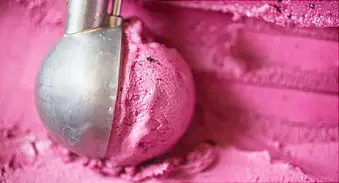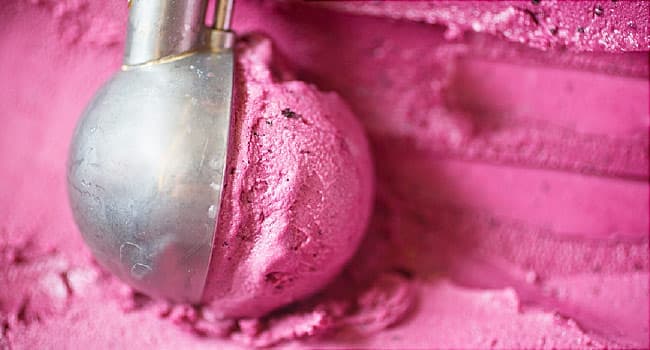The Scoop on Ice Cream

How is eating ice cream like being addicted to a drug?
- The more you eat, the less pleasure you get
- You always eat more each time
- It's hard to stop cold turkey
Over time, addicts build up a tolerance to drugs. Taking more doesn't give them as much pleasure as their initial highs. One study showed the same may be true with ice cream. Scientists looked at one group of teens who regularly ate ice cream and another group who didn't. The ice cream-eaters seemed to be de-sensitized to the milkshakes -- that is, the reward centers in their brains were less active than those of the group that ate ice cream less often.
Which has the most calories?
- A large order of fries
- A large vanilla shake
- Two large hamburgers
A milkshake may be a tasty treat but you definitely shouldn't indulge too often. One medium vanilla shake at Baskin-Robbins has 1,0200 calories and 34 grams of saturated fat. A large order of McDonald's fries has 490 calories. One scoop of premium ice cream has 250 to 350 calories and half a day's saturated fat.
How much ice cream does the average American eat a year?
- 8 pounds
- 22 pounds
- 19 pounds
We've generally eaten less ice cream since 1988, but the average person ate about 20 pounds over the course of the year.If you think that's high, consider the amount of ice cream people were eating in 1946. That year, Americans celebrated their victory in World War II and the end of sugar rationing by eating a whopping 23 pounds of ice cream per person.
Is light ice cream healthier than regular ice cream?
- Yes
- No
Light ice cream has at least 50% less fat or 33% fewer calories than regular ice cream, but that doesn't mean you should eat more of it. Chances are that even light ice cream has too much fat as well as extra sugar to make up for the effect reduction in fat has on flavor. Compare labels to help you choose the lower-fat option. And when you do have ice cream, measure out just a half a cup and savor every bite.
One of America's top 3 favorite flavors is:
- Neapolitan
- Chocolate chip
- Butter pecan
America's No.1 flavor of choice is Chocolate, according to a 2019 survey by the International Dairy Foods Association. Next up is cookies n’ cream, #3 is vanilla. Baskin-Robbins customers also like Mint Chocolate Chip and Cookies & Cream. Cookie Dough and Strawberry make the list with Yahoo users, too.
Which ice cream company has a "flavor graveyard" on its website?
- Haagen-Dazs
- Dreyer's
- Ben & Jerry's
The quirky duo behind the company famous for such flavors as Cherry Garcia (an homage to Grateful Dead front man Jerry Garcia) and Chubby Hubby (whose ingredients include fudge-covered peanut butter-filled pretzels) are not shy about their less-successful recipes. Among the flavors with headstones are Rainforest Crunch (1988-1988) and Bovinity Divinity (1998-2001).
How might you prevent an ice cream headache?
- Make sure your ice cream is really cold
- Stick to swirled flavors
- Eat your ice cream slowly
It's a shame that something so pleasurable can cause such sharp pain. An ice cream headache (or "brain freeze") happens when something cold hits the warm roof of your mouth. This sets off nerves that control how much blood flows to your head; the nerves cause the blood vessels to swell up, triggering pain.
Which type of ice cream cone contains the least calories and fat?
- Waffle cone
- Sugar cone
A sugar cone can have been 60 and 130 calories; a waffle cone can range from 120 to 160 calories. If you get fancier and opt for, say, a chocolate-dipped waffle cone at Ben and Jerry's, the waffle cone alone will cost you 320 calories and 12 grams of saturated fat.The best bet? Save your calories for the ice cream itself and order your dessert in a cup. That's calorie- and fat-free.
Which ingredient is in creamy, low-fat "slow-churned" ice cream?
- Tapioca
- A fish protein
- Arrowroot
The secret behind creamy, low-fat "slow churned" ice cream is a protein from the ocean pout fish, which raises the freezing point, keeping the ice cream creamier. This protein coats the fine ice crystals in the dessert, preventing it from recrystallizing.
Why does ice form on the top of ice cream?
- It's cheap ice cream
- You let the ice cream soften
- It's been in the freezer too long
A fluctuation in temperature is the most common reason for that layer of ice, so don't leave your ice cream sitting out. When the small crystals melt and re-freeze, they turn into lumps. Set your freezer between -5°F and 0°F, and keep ice cream in the main part of the freezer instead of on the door.
Why would you need to use salt when you're making homemade ice cream?
- To keep the mixture from curdling
- To balance the sweetness of the mixture
- To make the mixture cold enough to freeze
Most newer ice cream makers don't use salt. But if you have the old-fashioned kind that surrounds the tub with ice while it's turning, adding rock salt lowers the freezing point. The temperature of the ice and salt mixture goes below the normal freezing point of water, making the cream mixture cold enough to freeze.
Why does ice cream melt quickly on a hot, windy day?
- There isn't enough shade
- Heat flows from hot to cold
- The climate is very dry
It's a law of physics: Heat from the air is drawn to the cold ice cream to balance the temperature difference between them. The bigger the gap, the warmer the ice cream needs to get to even it out. Ice cream will also melt faster in a humid climate than in a dry one.
What's the difference between sorbet and ice cream?
- The serving size
- The temperature you serve it at
- The ingredients
Sorbet, a tangy and fruity treat, is often served between courses to cleanse the palate. People who are lactose-intolerant can eat sorbets because they're never made with dairy products.Sherbets can contain milk, eggs, or gelatin. Vegans (people who don't eat any animal products) can make ice cream with peanut butter, almond milk, coconut milk, and other dairy substitutes.
Do frozen yogurts have the same active probiotic cultures as regular yogurts?
- Yes
- No
Some frozen yogurts contain the beneficial "live and active" cultures found in a lot of yogurt. These cultures go dormant during freezing but become active again when eaten and returned to a warm temperature in the body. Look for the National Yogurt Association's voluntary Live & Active Cultures seal. Not all frozen yogurts -- or yogurts for that matter -- have live cultures though.
One full scoop of sorbet has more fat than half a scoop of ice cream.
- True
- False
One scoop of sorbet or soft-serve nonfat frozen yogurt at Haagen-Dazs has no saturated fat and about 170 calories. Compare that with half a scoop of their mint chocolate chip ice cream, which comes in at 180 calories and 8 grams of saturated fat.You could have a full scoop of sorbet and still come out ahead. But don't overeat; all of these contain a lot of sugar.
